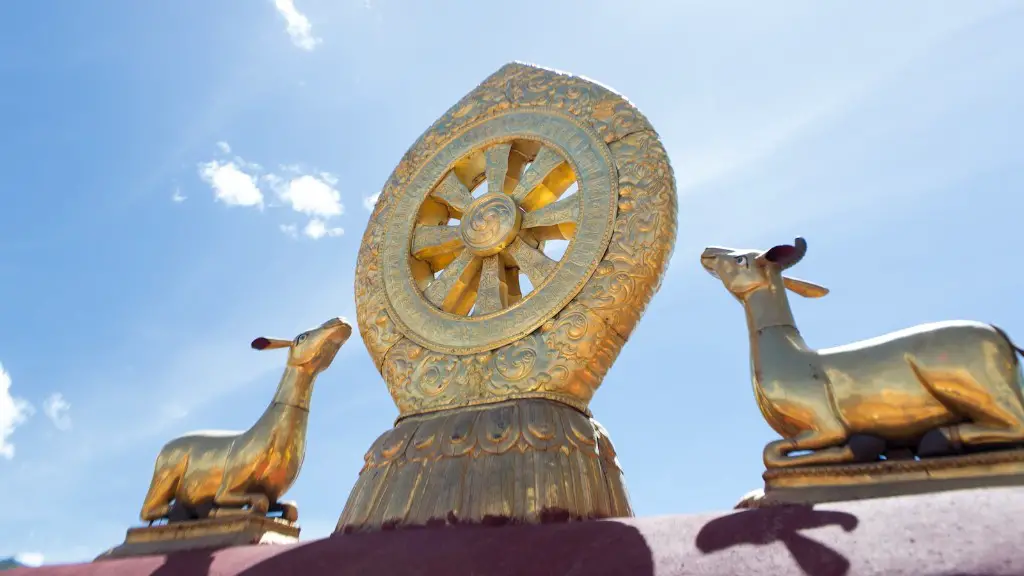There is no single answer to this question as Buddhism is a diverse religion with many different schools and traditions. However, some of the most common things that are considered sacred in Buddhism include the Buddha himself, the Dharma (the Buddhist teachings), and the Sangha (the community of Buddhist monks and nuns). Other sacred things may include certain statues, texts, and places of pilgrimage. In general, anything that is considered to promote the spiritual life and path of Buddhism is considered sacred.
Buddhism sacred teachings are the Three Jewels: the Buddha, the Dharma (the Buddha’s teachings), and the Sangha (the Buddha’s monastic community).
What is sacred to Buddhist belief?
Buddhists believe that human life is one of suffering. This suffering is caused by our desires and attachments. We can end our suffering by following the path of meditation, spiritual and physical labor, and good behavior. By doing this, we can achieve enlightenment, or nirvana.
The Five Precepts are the Buddhist versions of a code of conduct or rules to help people behave in a moral and ethical way. The Five Precepts are: (1) to not take the life of any sentient being; (2) to not take anything that does not belong to you; (3) to not engage in sexual misconduct; (4) to not tell lies; and (5) to not consume intoxicants.
What are the 3 sacred texts of Buddhism
The Tripiṭaka is the Buddhist scriptures, and is composed of three main categories of texts: the Sutra Piṭaka, the Vinaya Piṭaka, and the Abhidhamma Piṭaka. The Sutra Piṭaka is the largest category, and contains the Buddha’s discourses. The Vinaya Piṭaka contains the rules and regulations for monks and nuns. The Abhidhamma Piṭaka is a collection of philosophical texts.
There is no single place of worship in Buddhism because Buddhists can worship in the home or in the temple. Although Buddhists show devotion at home, they also use the temple as this is the heart of the community.
What are the 4 main beliefs of Buddhism?
The Four Noble Truths are the core of Buddha’s teachings, but they don’t explain everything. They’re the truth of suffering, the truth of the cause of suffering, the truth of the end of suffering, and the truth of the path that leads to the end of suffering.
Buddhists worship at temples or monasteries, where they meditate and pray. Some also set up shrines at home to worship privately. Buddhists believe that it is important to live in harmony with others and to treat everyone with respect.
Is a sacred Buddhist structure?
A stupa is typically a large, dome-like structure that is built to honor a specific person or event. Stupas were first used in India and spread to other parts of Asia from there. Although stupas are often associated with Buddhism, they actually predate the religion. Stupas were originally built as burial mounds or places to store religious relics. Over time, they evolved into more elaborate structures that served as places of worship and contemplation. Today, stupas can be found in many different cultures and religions.
The Four Noble Truths are the core teaching of the Buddha and are accepted by all schools of Buddhism. They are: suffering (dukkha), the cause of suffering (samudaya), the end of suffering (nirvana), and the path to the end of suffering (magga).
The first truth, suffering, is characteristic of existence in the realm of rebirth, called samsara. Samsara is a cycle of birth and death in which beings are trapped due to their ignorance and attachment. Suffering arises from our desires and our attachment to the transitory things of this world.
The second truth, the cause of suffering, is our ignorance and attachment. Ignorance is not knowing the true nature of reality, and attachment is our clinging to things that are impermanent. These two causes keep us trapped in the cycle of rebirth.
The third truth, the end of suffering, is Nirvana. Nirvana is the complete cessation of suffering, and it can be attained through our own efforts.
The fourth truth, the path to the end of suffering, is the Noble Eightfold Path. This path includes right understanding, right thought, right speech, right action, right livelihood, right effort, right mindfulness, and right
What food is forbidden in Buddhism
Buddhists believe that food should be prepared as a spiritual exercise with attention to balance, harmony, and delicacy. Buddhists also follow the practice of conscious eating, which means being mindful of the effects of what we eat on our bodies, minds, and the environment. The Buddha himself advised monks to avoid eating 10 kinds of meat for self-respect and protection: humans, elephants, horses, dogs, snakes, lions, tigers, boars and hyenas.
In Buddhist thought, animal life is also sacred. However, human life is considered more important because humans have the potential to achieve nibbana. This is due to human beings’ central position in the universe. This position cannot be shared with other sentient beings, including animals.
Do Buddhists believe in God?
Buddhism is a tradition focused on spiritual liberation, but it is not a theistic religion. The Buddha himself rejected the idea of a creator god, and Buddhist philosophers have even argued that belief in an eternal god is nothing but a distraction for humans seeking enlightenment.
The four Vedas are the earliest and most important sacred texts of Hinduism. They were written down in early times, and the content was divided into four genres: the Ṛg Veda, the Yajur Veda, the Sāma Veda, and the Atharva Veda. These four texts are essential to the study of Hinduism and are regarded as sacred by Hindus.
How do Buddhists pray
There is no one way to worship Buddha, but many worshipers find peace and solace in sitting on the floor barefoot, facing an image of Buddha, and chanting. Often, monks will chant from religious texts, which can be accompanied by instruments, and worshipers will take part in prayers. In this way, worshipers can connect with Buddha and the teachings of Buddhism.
With over 244 million Buddhists, China has the largest population of Buddhists in the world. The majority of these Buddhists follow the Chinese schools of Mahayana, making this the largest body of Buddhist traditions. Buddhism first came to China in the 1st century CE, and quickly gained popularity among the Chinese people. Today, Buddhism remains an important part of Chinese culture, with millions of people practicing the religion.
What is the symbol of Buddhism?
The Dharma Wheel is one of the most important symbols of Buddhism. It represents the Buddha’s teaching and the path to enlightenment. The wheel is usually depicted with eight spokes, which represent the Eightfold Path. The Dharma Wheel is a symbol of the Buddha’s teaching and the path to enlightenment.
The three are: (1) śīla (“moral conduct”), which makes one’s body and mind fit for concentration, (2) samadhi (“meditation”), concentration of the mind being a prerequisite to attaining a clear vision of the truth, and (3) prajna (“wisdom”), understood not as a collection of empirical .
What are 5 major rituals in Buddhism
Veneration is the act of showing respect or reverence for someone or something. In the Buddhist tradition, there are many ways to show veneration for the Buddha, bodhisattvas, and other holy figures. The most common types of veneration practices include merit-making, bowing, giving offerings, chanting, meditating on the qualities embodied by specific buddhas or bodhisattvas (such as compassion and wisdom), and pilgrimage. Each of these practices can help us to develop our own relationship with the Buddha and his teachings, and can also provide us with a deeper understanding of the Buddhist path.
Vajrapani is the bodhisattva who represents the power of all the buddhas. He is often shown holding a vajra, or “thunderbolt,” which symbolizes the power of Buddha’s truth.
Manjushri is the bodhisattva of wisdom. He is often shown holding a sword, which cuts through ignorance and delusion.
Avalokiteshvara is the bodhisattva of compassion. He is often shown with thousands of arms, representing his ability to help all beings who are suffering.
Warp Up
There is no one answer to this question as different things can be sacred to different Buddhists. However, some possible things that could be considered sacred to Buddhism include the Buddha himself, the Dharma (Buddhist teachings), and the Sangha (Buddhist community). Additionally, many Buddhists consider meditation and mindfulness to be sacred practices.
Buddhism is a religion that is based on the belief in reincarnation. This means that the soul is reborn into another body after death. The goal of Buddhism is to reach nirvana, which is a state of complete peace and freedom from suffering. There are many things that are sacred to Buddhism, such as the Buddha, the Dharma, and the Sangha.


